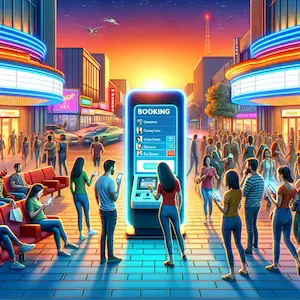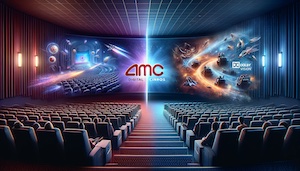Ever wonder where to sit when you walk into a 3D movie theater? Picking the right spot can make your movie way more fun!
This article will guide you on the best place to sit so you can enjoy every moment of the film. We’ll look at what experts say, what other moviegoers think, and even what science has to say. So, next time you’re at the movies, you’ll know just where to go!

Table of Contents
Where is the best place to sit in a movie theater for a 3D movie?
Being at the heart of the cinematic experience often means positioning yourself right in the screen’s central axis. The immersive allure of 3D movies is best felt when you’re considerably close to the screen. Each film, with its unique stereographic nuances, can influence this ideal distance. Typically, filmmakers design 3D depths to appear ‘behind’ the screen, nudging you to be nearer to the screen for the best experience. However, in those exceptional instances where 3D elements seem to ‘pop out’ from the screen, a slight retreat further back can enhance the viewing experience. In general, a ballpark recommendation is to situate yourself between 20–40% of the room’s depth, with 100% representing the entire depth of the room.
The Anatomy of a 3D Movie Theater
Understanding the structure and design of a movie theater is pivotal to choosing the best seat for a 3D viewing experience. Movie theaters, over the years, have been engineered not only for visual delight but also for acoustic brilliance.
- Screen The beating heart of any theater, the screen is where all the magic unfolds. In 3D movies, the screen is designed to reflect images in a way that when filtered through 3D glasses, provides depth perception.
- Front Section Proximity to Action: The seats closer to the screen offer a larger-than-life view. However, the overwhelming size can lead to frequent head movements, which might be discomforting during a 3D movie.Sound Dynamics: Being closer to the screen can sometimes mean you’re also nearer to the front speakers. This might make certain sound elements, like dialogues, appear louder.
- Middle Section Visual Sweet Spot: Often considered the ‘Goldilocks’ zone. Here, you’re neither too close nor too far, ensuring a balanced view with minimal distortions.Acoustic Balance: Sitting in the middle also means you’re in the midst of surround sound speakers, ensuring that you get an even distribution of audio from all directions.
- Back Section Panoramic Perspective: Seats here offer a complete, overarching view of the screen. Ideal for folks who like to take in everything at once.Sound Delay: Given that sound travels, sitting at the very back might mean that the audio could reach you a fraction of a second later than the visuals, although most modern theaters have this issue rectified.
- Sideways – Left and Right Wings Angled View: These offer a different perspective as you’re viewing the screen from an angle. This might slightly distort the 3D perception.Sound Skew: Depending on the positioning of the speakers, the audio might seem louder from one side and softer from the other.
- Aisles and Exit Paths Ease of Movement: Seats near aisles offer the convenience of quick exits, be it for a restroom break or at the end of the show.Light Distractions: Seats adjacent to exit paths might experience occasional light seepages, especially if the theater doors are not entirely light-proof.
Factors to Consider When Choosing Your Sea
Deciding where to sit in a movie theater, especially for a 3D screening, is more than just about preference. There are multiple considerations that can amplify or dampen your cinematic experience.
- Angle of View This pertains to the angle at which you’re viewing the screen. A direct, head-on angle often results in the most undistorted view. Seats that make the screen appear tilted or skewed may not only distort the 3D effect but also strain the eyes.
- Distance from the Screen This can be a game-changer. While sitting too close can be overwhelming and cause you to move your head often, being too far might weaken the 3D effects. Finding a sweet spot where the screen fills your field of vision without causing discomfort is key.
- Surround Sound Experience Modern theaters use surround sound systems that are designed to provide an immersive audio experience. Your position in the theater can greatly influence how sound waves reach your ears. Being off-center or too close/far from specific speakers can alter this experience.
- 3D Glasses Compatibility Some spots, especially on the extreme sides or very close to the screen, might not be compatible with the angle required for 3D glasses to work their magic. It’s essential to ensure that the depth and layers of the 3D effects are evident from your chosen seat.
- Crowd and Company Who you’re with and who’s around you can influence your experience. If you’re with a group, center seats might allow for shared reactions. If you’re solo, an aisle seat might give you a bit more personal space. Consider potential distractions too – like a chatty neighbor or someone frequently on their phone.
- Comfort and Legroom The physical comfort of the seat matters, especially for longer films. Some seats, especially those near aisles or exit rows, might offer more legroom. Remember, comfort can greatly influence your overall movie-watching experience.
- Ease of Access Consider how easy it is to get in and out of the seat. If you anticipate needing frequent restroom breaks or if you like to stretch occasionally, an aisle seat might be your best bet.
- Personal Preference and Past Experience Sometimes, the best guide is your own past experience. If you’ve previously found a spot that gave you an optimal 3D viewing experience, it might be worth revisiting.
Taking the time to weigh these factors ensures not just a visually delightful experience but also one that’s comfortable and memorable. After all, a movie, especially in 3D, is not just about watching; it’s about immersing yourself in a different world.
What Science Tells Us is the Best Place to Sit in a 3D Movie
The optimal viewing experience for a 3D movie is influenced by multiple scientific factors, from the anatomy of the human eye to the technology behind 3D projection. Here’s a look at what science has to say about the best place to sit in a 3D movie.
- Visual Field and Screen Size The human eye’s field of vision is central to this discussion. Scientifically, for optimal 3D viewing, the screen should fill about 40% of your horizontal field of vision. This means that you shouldn’t be too far away where the screen looks tiny, nor too close where you have to keep turning your head. Typically, this sweet spot is found in the middle or just behind the middle of the theater.
- Angle of Projection Research indicates that an angle of 15 degrees below the horizontal line of sight offers the best 3D experience. In layman’s terms, this means that your eyes should ideally be level with the bottom third of the screen. Again, this typically situates viewers around the center of the theater, but this can vary based on theater design.
- Convergence and Focus in 3D 3D movies play a trick on our brains. They make our eyes converge (or focus) at a point different from where they’re focusing. This difference can be tiring for the eyes if not positioned optimally. Seats placed too close to the screen exaggerate this difference, leading to quicker eye fatigue.
- Sound and Acoustics While the visuals are paramount in a 3D movie, the auditory experience shouldn’t be neglected. The design of modern theaters is such that the sound is most balanced around the center of the theater – not too close or too far from any set of speakers. This ensures you’re at the focal point of the surround sound.
- Light Intensity and Polarization 3D movies use polarized light to create the illusion of depth. For the polarization to work effectively with your 3D glasses, it’s important to view the screen head-on. Seats on the extreme sides or at odd angles may compromise the 3D effect due to changes in light polarization.
Personal preferences will always play a role, science suggests that the middle of the theater, both in terms of distance from the screen and height, offers the most immersive 3D movie experience. It’s a blend of visual comfort, auditory delight, and reduced eye strain. So, next time you’re headed for a 3D blockbuster, you might want to aim for the center!
FAQ
What is the optimal position to sit in a 3D movie theater?
The best position for an immersive 3D experience typically lies around the center of the theater. This means being at the middle of the screen’s central axis and sitting at a distance of about 20–40% of the room’s depth, with 100% being the entirety of the room.
Does sitting too close to the screen affect the 3D experience?
Yes, being extremely close can be overwhelming, causing you to move your head frequently and might exaggerate the differences between where your eyes converge and where they focus, leading to quicker eye fatigue.
See Related Posts

Average Cinema Screen Size

Movie Theater Popcorn at Home

Movie Theaters on Cruise Ships

Recliner Seat Movie Theater

Do you have to book Cinema Tickets in advance?

AMC Digital vs. Dolby

Best Seats in Theater for Movie

Biggest IMAX Screens in NYC

Nutritional Value of Movie Theatre Popcorn
